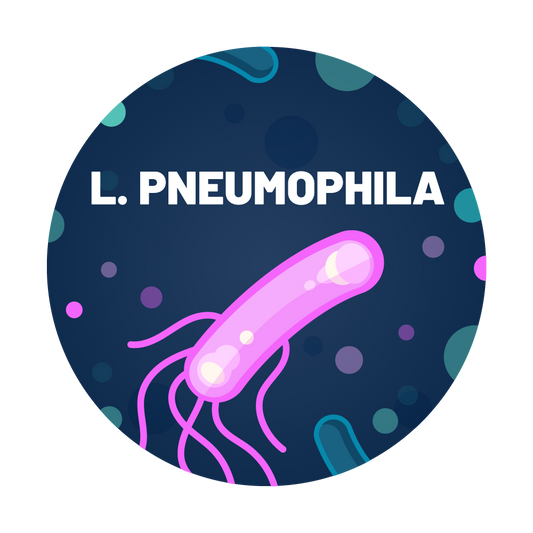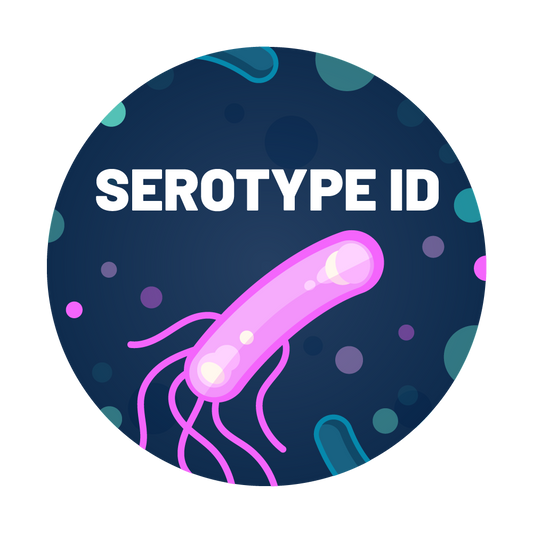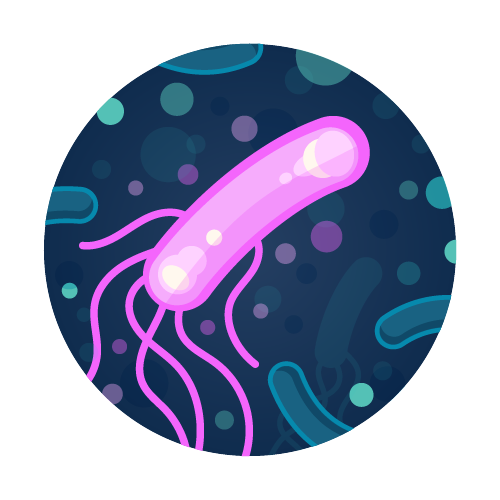
Legionella in Drinking Water: What You Need to Know At Home or Away
Our blog is written by real experts— not AI. Each guide is carefully reviewed and updated based on the latest research. Plus, with no affiliate links, you can count on unbiased insights you can trust.
Legionella is a bacteria that grows naturally in freshwater environments. But when it gets into water systems, Legionella can become a real nuisance. Legionnaires’ disease is a severe form of pneumonia caused by the pathogenic Legionella pneumophila. Outbreaks of legionellosis—Legionella-caused illness—are not uncommon, especially in spas and hotels.
If you have any reason to believe your home might be suffering from Legionella contamination, we’ve got you covered. The following contaminant guide will fill you in on everything Legionella, including when and how to test for Legionella.
Table of Contents:
- What Is Legionella?
- When Is Legionella Harmful to Your Health?
- When Should I Test for Legionella?
- How Do I Test for Legionella?
- What About Legionella in Hotels and Vacation Rentals?
- What Can I Do About Legionella?
- What’s the Takeaway?
What Is Legionella?
Legionella is a genus of rod-shaped bacteria, some species of which are pathogenic. It occurs naturally in freshwater environments, like lakes, rivers, and streams, but can become a health concern when it grows and spreads in building water systems—like cooling, plumbing and distribution systems.
Where Does Legionella Grow?
Legionella grows in building water systems that are not adequately managed, especially those where disinfectant levels are low, water is stagnant, or water temperatures are optimal for growth (77°F - 113°F).[1]
Human-made hot and cold water systems where Legionella may proliferate include:
- Showerheads and sink faucets
- Hot tubs
- Hot water tanks and heaters
- Cooling towers
- Aerators
- Ice machines
- Centrally installed misters, atomizers, air washers, and humidifiers
- Decorative fountains and water features
Home and car air-conditioning units do not use water to cool the air, so they are not at risk for Legionella growth.
When Is Legionella Harmful to Your Health?
Legionella becomes harmful when a pathogenic species, typically Legionella pneumophila, infects a person. L. pneumophila can cause Legionnaires’ disease, a particularly severe form of pneumonia, as well as Pontiac Fever, a milder, flu-like illness. Collectively these illnesses are known as legionellosis.
Legionella typically infects people one of two ways:
- Inhalation of aerosols (tiny droplets or vapors of contaminated water)
- Or, less commonly, aspiration (when water accidentally enters the lungs while drinking)
Most often, the disease is not spread person to person. Furthermore, drinking water contaminated with Legionella does not typically cause illness.[2]
According to OSHA, population-based studies estimate some 8,000-18,000 people are hospitalized with Legionnaires’ disease each year.[3]
Of the many species of Legionella, L. pneumophila is responsible for 90% of human disease. From L. pneumophila’s 14 serogroups (Sg), Sg1 causes more than 84% of Legionnaires’ disease worldwide.[4]
Symptoms of Legionella Infection
Symptoms of Legionella infection (either Legionnaires’ disease or the milder Pontiac fever) include:
- High fever
- Chills
- Cough
- Muscle, body, and/or headaches
- Diarrhea
Healthy people often recover from Legionnaires, but usually require hospitalization. Elderly and immunocompromised people have an increased risk of complications.[5]
When Should I Test for Legionella?
You should test for Legionella when:
- Someone in your household gets sick with Pontiac fever or Legionnaires’ Disease.
- You return to a building that has been vacant for a long period of time or water has been stagnant for any period.
- You notice biofilm buildup or other microbial growth on shower heads, fixtures, or faucets. (Biofilm is a slime-like accumulation of linked microorganisms bonded to a surface.)
Factors that Promote Legionella Growth
- Construction
- Water main breaks
- Biofilm buildup
- Scale and sediment
- Water temperature fluctuations
- pH fluctuations
- Inconsistencies in disinfection
- Changes in water pressure
- Water stagnation
Note: In addition to pipes, point-of-use (POU) faucet filters and water storage units are susceptible to Legionella growth.
Why Does Legionella Grow in Unused Plumbing?
Plumbing that does not get adequate use develops stagnant water. Stagnant or “standing” water is water that sits without movement or aeration for extended periods of time. This is a prime breeding ground for biofilms and harmful bacteria and fungi.
Stagnant water also promotes sediment and corrosion in pipes, which in turn promotes biofilm buildup and provides food for bacteria. Additionally, reduced water temperatures in empty buildings promote bacterial growth.
How Long Does it Take for Legionella to Grow in Plumbing?
If present, Legionella can grow significantly within weeks or months of inactivity, depending on factors like water temperatures, residual disinfectant concentrations, and preexisting Legionella colonies.[6]
Microbes like coliform, pseudomonads, and other heterotrophic bacteria (which include Legionella) are prone to regrowth.
How Do I Test for Legionella?
There are four effective methods to test for the presence of Legionella bacteria:
- PCR Method (laboratory)
- Culture Method (laboratory)
- DFA Method (laboratory)
- Lateral flow method (at-home, less common)
While there are more than 30 species of Legionella, L. pneumophila is responsible for the bulk of human infection.
PCR Method
The polymerase chain reaction (PCR) method is used by laboratories to provide quick results (72 hours) for Legionella detection.
PCR results are faster and more convenient than the other laboratory methods but are more prone to false negatives through environmental interference (like debris, heavy metals or other chemicals).
Culture Method
The culture method detects Legionella colonies in a laboratory setting using BCYE or BCYE-modified agar. Culture tests take slightly longer (4-10 days) than PCR but can test for a wider range of serogroups.
Culture methods can also produce false negatives, particularly when water samples are taken from hot tubs, fountains, or cooling towers which are prone to competing microbial growth.
DFA Method
The direct epifluorescent monoclonal antibody (DFA) method is the most sensitive and specific testing method, developed by the Center for Disease Control & Prevention (CDC).
DFA tests are not typically prone to false negatives, but not all laboratories have the equipment and expertise necessary to perform them.
Lateral Flow Method
The lateral flow method is an emerging, at-home DIY testing method for Legionella. This diagnostic process is the same as at-home, rapid Covid-19 and pregnancy tests.
In this case, lateral flow immunochromatographic assay (LFICA) provides results within 30-60 minutes, but tests only for L. pneumophila Sg1, one of the three serogroups responsible for the bulk of human infection. False negatives are a risk with at-home tests.
Legionella Testing Certifications
-
ISO 11731 Standard for Legionella Enumeration
This standard by the International Standard Organization specifies culture methods for the isolation of Legionella and estimation of their numbers in water samples. It can be applied to all kinds of water samples, including potable, industrial, waste, and natural waters. The methods can also be applied to biofilms, sediments, etc.[7]
Not all Legionella species are culturable, however. This method applies solely to those species that are. (L. pneumophila is a culturable form of Legionella.)
Comprehensive Legionella Water Test—SimpleLab Tap Score
Legionella pneumophila Serotype Water Test—SimpleLab Tap Score
-
CDC Elite
Legionella can be difficult to isolate. The Environmental Legionella Isolation Techniques Evaluation (ELITE) Program was created by the CDC for laboratories to test their Legionella isolation techniques against standardized samples.
The ELITE program identifies laboratories that can isolate (grow and identify) Legionella using the culture method. But the certificate does not guarantee the laboratory will be able to isolate Legionella from every received sample as that ability is dependent on the quality of the received sample.[8]
Legionella pneumophila Serotype Water Test—SimpleLab Tap Score
Note: Depending on the specific lab, the same test may be run by various methods.
How Do I Know Which Legionella Test Is Right for Me?
Of the four Legionella tests covered above, the lateral flow (at-home) test offers the most immediate results. If someone in your party is sick or showing signs of legionellosis, you’ll want to know right away. However, residential lateral flow tests are not widely available.
On the other hand, only the laboratory testing methods (PCR, culture, DFA) will be able to isolate which form of Legionella is in your water, and allow you the versatility to test a variety of sources (faucets, showerheads, water heaters, etc.).
The multiple analyte tests below (“serotype” and “comprehensive”) are recommended for those looking to reopen a building or facility that has been under a prolonged shutdown or limited operations. They are also helpful when spotting biofilm buildup in and around your sinks, faucets, showerheads, filtration devices, etc.
Legionella pneumophila Water Test
Test your drinking water for Legionella pneumophila.
Legionella pneumophila Serotype Water Test
Test your water for Legionella pneumophila, including advanced analysis for serotype identification and enumeration.
Comprehensive Legionella Water Test
Test your water for an array of Legionella bacteria species and serotypes with this advanced analytical package.
Why Test for Legionella in a Lab?
Legionella water testing is most frequently carried out in a laboratory because of the expertise available. Testing for Legionella is complicated and requires precision to be effective, especially in the face of the health risks associated with pathogenic Legionella. At home tests are susceptible to inaccurate results.
What About Legionella in Hotels and Vacation Rentals?
Legionella is most commonly associated with hotels, resorts, and vacation rentals. Hotels and resorts typically have very complex water systems with a vast network of hot tubs, pools, showers, cooling towers, etc. that are prone to Legionella growth.
Vacation rentals on the other hand remain vacant for stretches at a time which can promote Legionella growth in a variety of places if they’re not properly maintained.
Hotels and Resorts
Ideally, hotels and resorts should have water management teams that understand the water systems in place and can identify all the areas in the network where Legionella can grow and spread. These areas should be properly managed and monitored to help protect public health.
The three most important water parameters for management teams to monitor are:
- Temperature (keeping it outside the ideal Legionella range of 77°F-113°F)
- Disinfectant levels (at both point-of-entry and point-of-use)
- pH levels (disinfectant works best within specified pH ranges)
Water and fixtures in hotels and resorts should be routinely sampled for Legionella.
Vacation Rentals
Vacation rentals won’t typically have water management teams. In addition to monitoring all household plumbing fixtures, pay close attention to hot tubs. Hot tubs should maintain adequate disinfectant levels (3–10 PPM for free chlorine or 4–8 PPM for bromine) and pH (7.2–7.8), even when the hot tub is not in use.[10]
According to a Legionnaires’ Disease survey, half of all participants with Legionnaires’ disease who traveled to a vacation rental reported using the hot tub.
There is no known safe level of Legionella in a building water system. Legionnaires’ cases have even been linked to buildings with very low levels of Legionella.
What Can I Do About Legionella?
Luckily, Legionella contamination is less common for homes in active use. But it’s still important to be on the lookout for biofilm around shower heads and fixtures.
If Legionella is becoming an issue in your home or vacation rental, you might want to look into your plumbing system to identify the source. Areas where water is becoming stagnant frequently should be addressed.
Tips to minimize Legionella growth at home or vacation property rentals:
- Shock chlorinate your water system regularly if you’re on a private well
- Flush out showers or faucets that aren’t used frequently (including guest houses or guest bathrooms) at least once a week
- Regularly flush out or remove dead legs from infrequently used pipe networks
- Flush out your pipes after a water main break or damaging event
- Keep your water system components like water heaters, mixing valves, aerators, showerheads, hoses, and filters clean and regularly maintained
Water treatment options are also an option (like reverse osmosis or microfiltration systems). But again, if Legionella control is an issue in an active household, it’s recommended you address the areas of your plumbing or water systems that could be breeding Legionella.
The CDC has also prepared a guide to controlling Legionella in drinking water systems.[9]
What’s the Takeaway?
Getting a handle on Legionella in home water supplies is vital to lowering the risk of preventable illnesses like Legionnaire’s disease and Pontiac fever.
- Legionella thrives in building water systems that are not adequately managed, especially those where disinfectant levels are low, water is stagnant, or water temperatures are optimal for growth. Showerheads and faucets, cooling towers, hot tubs, hot water tanks, and other large, complex plumbing systems are all susceptible.
- You should test for Legionella:
- When a building has quantities of stagnant water or is to be reactivated after prolonged vacancy
- As a part of a robust water management program at hotels or resorts
- If you or someone in your party gets sick after being exposed to water from any of the water systems detailed above
- You can test for Legionella at home with rapid, lateral flow tests or by using more comprehensive laboratory test kits offering varying levels of analysis.
- Legionnaires Disease Cause and Spread - Legionella Home
- Legionella Guidance for Community Public Water Systems, Health Care Facilities, and All Types of Buildings
- Legionellosis (Legionnaires' Disease and Pontiac Fever) - Overview | Occupational Safety and Health Administration
- Specific Real-Time PCR for Simultaneous Detection and Identification of Legionella pneumophila Serogroup 1 in Water and Clinical Samples
- Legionnaires Disease Diagnosis and Treatment | CDCs
- Maintaining or Restoring Water Quality in Buildings With Low or No Use | EPA
- ISO 11731:2017 - Water quality — Enumeration of Legionella
- CDC - ELITE Program
- Controlling Legionella in Potable Water Systems | CDC
- Considerations for Vacation Rental Owners and Managers | CDC
- Legionella Serology - LabPLUS















